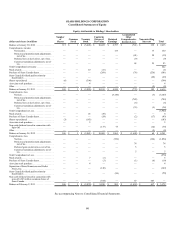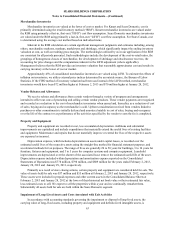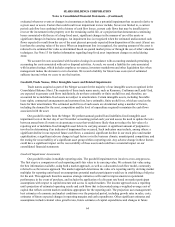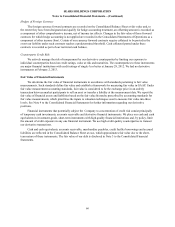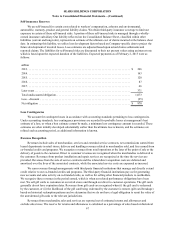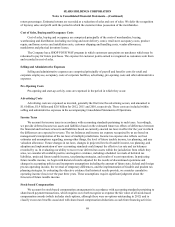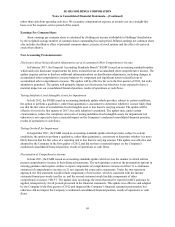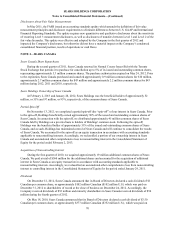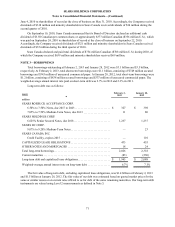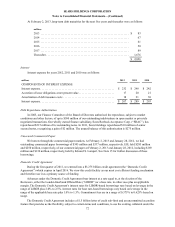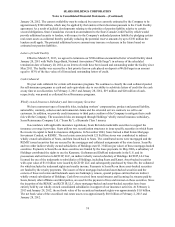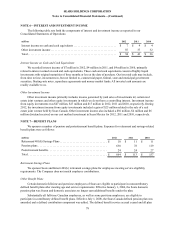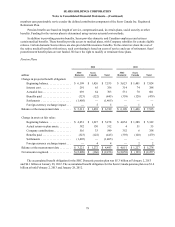Sears 2012 Annual Report Download - page 69
Download and view the complete annual report
Please find page 69 of the 2012 Sears annual report below. You can navigate through the pages in the report by either clicking on the pages listed below, or by using the keyword search tool below to find specific information within the annual report.SEARS HOLDINGS CORPORATION
Notes to Consolidated Financial Statements—(Continued)
69
rather than cash from operating activities. We recognize compensation expense as awards vest on a straight-line
basis over the requisite service period of the award.
Earnings Per Common Share
Basic earnings per common share is calculated by dividing net income attributable to Holdings' shareholders
by the weighted average number of common shares outstanding for each period. Diluted earnings per common share
also includes the dilutive effect of potential common shares, exercise of stock options and the effect of restricted
stock when dilutive.
New Accounting Pronouncements
Disclosures about Reclassification Adjustments out of Accumulated Other Comprehensive Income
In February 2013, the Financial Accounting Standards Board (“FASB”) issued an accounting standards update
which adds new disclosure requirements for items reclassified out of accumulated other comprehensive income. The
update requires entities to disclose additional information about reclassification adjustments, including changes in
accumulated other comprehensive income balances by component and significant items reclassified out of
accumulated other comprehensive income. The update will be effective for us in the first quarter of 2013, but early
adoption is permitted. The update will primarily impact our disclosures, but otherwise is not expected to have a
material impact on our consolidated financial position, results of operations or cash flows.
Testing Indefinite-Lived Intangible Assets for Impairment
In July 2012, the FASB issued an accounting standards update which provides, subject to certain conditions,
the option to perform a qualitative, rather than quantitative, assessment to determine whether it is more likely than
not that the fair value of an indefinite-lived intangible asset is less than its carrying amount. The update will be
effective for us in the first quarter of 2013, but early adoption is permitted. The update may, under certain
circumstances, reduce the complexity and costs of testing indefinite-lived intangible assets for impairment, but
otherwise is not expected to have a material impact on the Company’s condensed consolidated financial position,
results of operations or cash flows.
Testing Goodwill for Impairment
In September 2011, the FASB issued an accounting standards update which provides, subject to certain
conditions, the option to perform a qualitative, rather than quantitative, assessment to determine whether it is more
likely than not that the fair value of a reporting unit is less than its carrying amount. This update was effective and
adopted by the Company in the first quarter of 2012 and did not have a material impact on the Company’s
condensed consolidated financial position, results of operations or cash flows.
Presentation of Comprehensive Income
In June 2011, the FASB issued an accounting standards update which revises the manner in which entities
present comprehensive income in their financial statements. The new guidance removes the presentation options in
existing guidance and requires entities to report components of comprehensive income in either (1) a continuous
statement of comprehensive income or (2) two separate but consecutive statements. Under the two-statement
approach, the first statement would include components of net income, which is consistent with the income
statement format previously used by us, and the second statement would include components of other
comprehensive income (“OCI”). The update does not change the items that must be reported in OCI and must be
applied retrospectively for all periods presented in the financial statements. This update was effective and adopted
by the Company in the first quarter of 2012 and impacted the Company’s financial statement presentation, but
otherwise did not impact the Company’s condensed consolidated financial position, results of operations or cash
flows.



